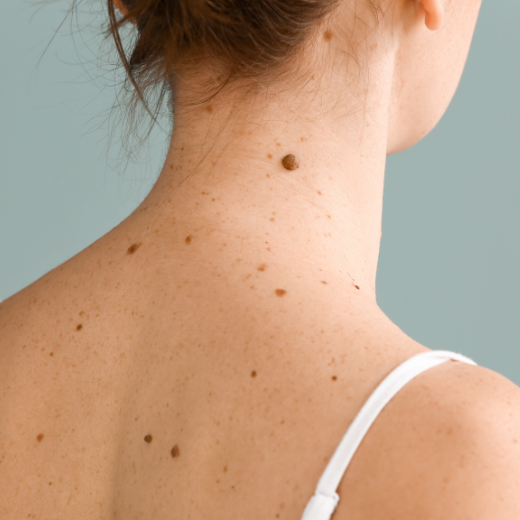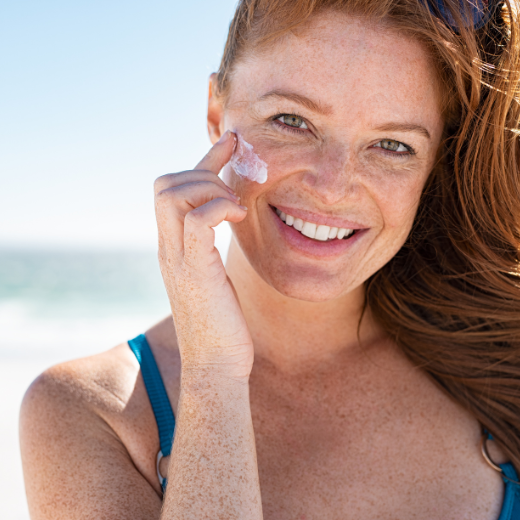Are You High-Risk for Melanoma? How to Know and What to Do
Posted by Nikki Wisher on May 24th 2024
If there’s one thing skin care experts harp on above everything else, it’s sun protection…and for good reason. Excess sun exposure can be bad for your skin from both a health perspective and a cosmetic perspective. It’s a major factor in premature aging and it’s to blame for age spots, but because we’re honoring Skin Cancer Awareness Month this May, today let’s focus on the health side of sun protection.
Melanoma and other skin cancers are a risk for everyone, no matter your family history, skin color, or other factors, but the fact is that some people are at a higher risk than others. If you are high-risk for melanoma, that affects how you should care for your skin. So how do you know if you meet the high-risk criteria and what’s the next step if you do? Settle in because I’ve got the details you need to know.
Factors That Might Make You High-Risk for Melanoma
Just like many diseases, melanoma has many different risk factors that affect how likely you are to develop the condition. You might be considered high-risk for melanoma if you have a few or more of these risk factors:
- Prior skin cancer, whether it was melanoma or another type of skin cancer like basal cell carcinoma or squamous cell carcinoma
- A lot of sun exposure and/or sunburn in your past – we’re talking all the way back to childhood, including outdoor sun exposure along with indoor tanning beds. Even one severe sunburn in your life raises your chances of melanoma significantly.
- Lots of moles. Practically everyone has at least a mole or two. But if you have a lot of moles, you’re more likely to develop melanoma. That’s because melanoma is skin cancer that starts in a particular type of skin cell called a melanocyte, and a mole is a grouping of melanocytes. So the more you have groups of those cells together in the form of a mole, the more opportunities there are for melanoma to form.
- Atypical moles. We all know what a standard mole looks like – brown, round, and fairly small. An atypical mole is a mole that’s outside the norm, whether it’s large (bigger around than a pencil eraser), unusually colored, abnormally shaped, etc.
- A weakened immune system. Your immune system helps your body resolve sun damage before it can accumulate and become cancerous. If your immune system is weakened by things like immunosuppressant medicine, HIV, or other immune-compromising circumstances, your risk for melanoma is higher.
- Light skin, hair, and/or eyes. Pigment helps your skin protect itself against the sun damage that builds into melanoma, so if you have less pigment, your risk for melanoma is higher.
- Living closer to the sun. Essentially, the closer you are to the sun, the more powerfully the sun will affect you. You’re at higher risk if you live closer to the equator but also if you live at a high altitude.
- A low Fitzpatrick skin type. The Fitzpatrick skin type scale is a way to categorize your skin based on, primarily, how it responds to the sun. It has skin types 1-6: type 1 burns easily in the sun and never tans. Type 6 skin never burns in the sun and always tans. The lower your skin type is (AKA the more easily you get sunburn) the higher your melanoma risk.
- Advanced age. Skin cancer forms when sun damage accumulates over time. So, naturally, the older you are the more time you’ve had to accumulate sun damage.
- A family history of melanoma. Even if there’s just one other person in your family who has had melanoma, it’s a sign that your risk is higher too because susceptibility can run in families.

What to Do if You are High-Risk for Melanoma
If you’ve taken an inventory with the list above and said, “Uh-oh, I have several of these,” what do you do now? It doesn’t mean you’ll surely get melanoma, it just means you should make a few adjustments to the way you care for your skin. Follow these important tips if you’re high-risk for melanoma.
1. Get more frequent skin cancer screenings.
For most people, dermatologists recommend visiting them once a year for a full skin cancer screening. If you’re high-risk for melanoma, though, your dermatologist may recommend that you have screenings more often like every six months. It’s also a good idea to perform self-exams at home every month or so to take note of any spots on your skin that have changed.
2. Make sunscreen a non-negotiable daily routine.
Truth be told, we should all be doing this, but it’s especially important if you have a higher risk for melanoma. Just make it part of your morning skin care routine. Make sure you’re using broad-spectrum sunscreen with an SPF of 30 or higher. I personally love tinted sunscreens because they give my skin tone a little more evenness and don’t leave white residue behind.
3. Choose your outdoor time wisely.
Just because you have an elevated melanoma risk doesn’t mean you have to stop enjoying the beautiful outdoors. But it can help if you’re strategic about when you spend time outside. The sun is at its strongest between 10am and 4pm, so try to minimize your time outside during those hours. Opt for sunrise hikes instead and lounge on your patio for happy hour rather than a mid-day sunning.
4. Avoid tanning beds.
You’ve probably heard this one a million times but it’s worth restating. As much as you might love the look of a great tan, that tan is a sign that your skin has taken on a damaging amount of sun exposure and it’s trying to protect itself. The good news is that spray tans and sunless tanning products have gotten a lot better since days when we all walked around looking like we’d fallen into a giant Cheetos bag, so there are beautiful alternatives out there. Just make sure you’re using a body lotion too because that hydration helps you get a nice even look.
Learning to Protect Your Skin This Skin Cancer Awareness Month
Preventing skin cancer should be a priority for us all. This Skin Cancer Awareness Month, you can protect your skin better by learning about your risk factors and making even minor changes to your daily routine to keep your skin safe. Enjoy safe sunshine this summer!


